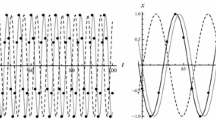Abstract
In this paper a slightly different approach is proposed for the process of determining the functions S m and H m * of the algorithm of the canonical version of Hori method. This process will be referred to as integration theory of the mth order equation of the method. It will be shown that the ordinary differential equation with an auxiliary parameter t * as independent variable, introduced through Hori auxiliary system, can be replaced by a partial differential equation in the time t. In this way, the mth order equation of the algorithm assumes a form very similar to the one of other perturbation methods. In virtue of this new approach of the integration theory for Hori method, Lagrange's variational equations introduced by Sessin are revised. As an example, the Duffing equation is solved through this new approach.
Similar content being viewed by others
References
Hori, G.: 1966, 'Theory of general perturbations with unspecified canonical variables', Publ. Astr. Soc. Japan 18, 287-295.
Lanczos, C.: 1970, The Variational Principles of Mechanics, 4th edn, University of Toronto Press, Toronto.
Nayfeh, A. H.: 1973, Perturbation Methods, John Wiley & Sons, New York.
Sessin, W.: 1983, 'Lagrange variational equations from Hori's method for canonical systems', Cel. Mech. 29, 361-366.
Author information
Authors and Affiliations
Rights and permissions
About this article
Cite this article
Da Silva Fernandes, S. Notes on Hori Method for Canonical Systems. Celestial Mechanics and Dynamical Astronomy 85, 67–78 (2003). https://doi.org/10.1023/A:1021711221662
Issue Date:
DOI: https://doi.org/10.1023/A:1021711221662



